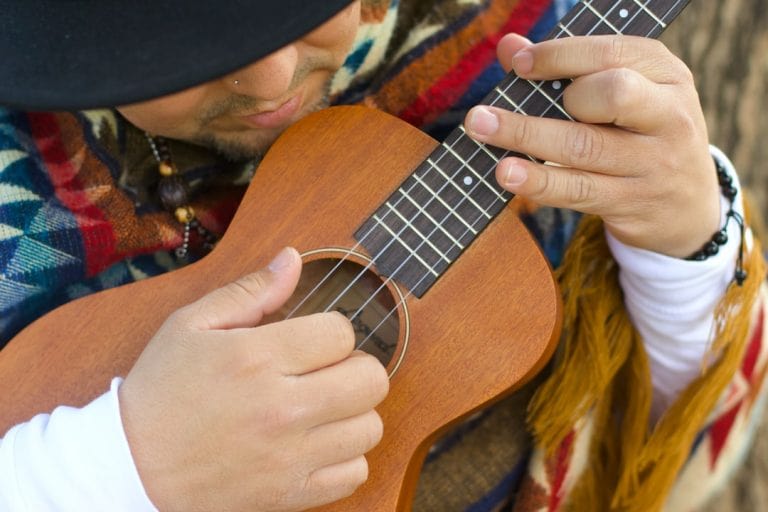- Home/
- Guides/
- Ukulele Lessons/
- How to Tune a Ukulele

Learn how to tune a ukulele so it sounds great
Get help with your ukulele lessonsLast Updated on
There are many key elements of becoming a great uke player, but the most important first step is learning how to tune a ukulele. Let’s be honest; it’s pretty much a musical dealbreaker if your instrument is out-of-tune!
Your family, neighbours, and audience will thank you for learning this crucial first step, and you’ll be well on your way to creating the beautiful sounds the ukulele is capable of.
The ukulele needs to be tuned frequently to offer its best sound, roughly every 15 minutes. Cheaper ukuleles require more frequent tuning when compared to the higher-end models. Read on to learn everything you need to know about how to tune a ukulele, and you’ll be on your way to becoming a master!
Standard ukulele tuning
Tuning is a matter of preference and also dependent on the other instruments you are playing with, the type of songs you are playing, and a host of different possible variations. To start with, however, the standard tuning of a ukulele sees the open strings most commonly tuned to the notes G, C, E, and A.
Some prefer to string their ukulele with a different option of a low G string (Linear Tuning) for a more rounded sound rather than a high G (Reentant Tuning).
If you’re used to playing the guitar, the high g-string may seem odd. In standard reentrant tuning, the strings do not go from lowest to highest. This gives a bright and charming sound with an even tone because the strings are in a smaller range.
The variance of tuning the g-string down an octave, linear tuning, arranges the stings from lowest to highest for a broader range that is fuller and resonant. To do this, you will need a special set of low G strings based relevant to your ukulele size. It would be best if you did not tune down High-g ukulele strings an octave.
How to tune a ukulele the quickest way
There are various versions of the ukulele, including soprano, concert, and tenor, but the tuning process’s essentials remain the same. The fastest and easiest way for how to tune a ukulele is with a chromatic tuner.
A chromatic tuner detects a note’s pitch and lets you know if it is sharp or flat relative to the note you are aiming for. You can find many variations of this tuning device, including pedals, units that clip onto the headstock of your ukulele, apps for your smartphone and more.
If you are playing live, a pedal tuner will likely be your best option. You can have this hooked up to your ukulele at all times and turn it on via a footswitch which makes for quick tuning – even while playing. Many musicians have a pedal tuner as one of the key pieces of equipment in their pedalboard. It works alongside a range of other effect pedals that can alter the sound of your instruments like delays, distortions and more.

How to tune a ukulele by ear
This form of tuning takes a lot of time and practice, and you train your mind to understand where a note should sit naturally. To learn this method, listen to the various notes’ pitches as a point of reference and hum along to get the note in your head. You’ll need to do this before plucking the strings.
Once you’re confident you have the pitch in your head, pluck the string you are trying to tune. If the string’s pitch is higher than the correct sound, your string is sharp. If the pitch is lower, your string is flat. Turn your tuning pegs until the pitches line up.
How to tune a ukulele if you’re a lefty
If you are a dominant left-hander, you will need to re-string your strings in the opposite order and then tune them accordingly. Avoid flipping the ukulele or play it upside down, as you will likely find it easier to play “left-handed” if by re-stringing the ukulele in the inverse.
You’ll need to push through a little awkwardness at the beginning while you are learning to play like this, but it will make things much easier later on.
How to tune a ukulele to alternate tunings
While we have mentioned the standard tuning option, there are many others. Above all when it comes to music, there are no rules so long as what you are doing sounds good!
Tuning is a matter of preference above all else, but along with standard tuning, here are some of the other popular ukulele tunings that you can try out.
Baritone tuning (D, G, B, E)
Baritone ukuleles and even tenor ukuleles can use this tuning which is the equivalent to the tuning of the last four strings on a guitar. Also known as “G tuning”, this option will give a full warm sound.
Slack-key tuning (G, C, E, G)
You can’t play the ukulele without wanting to attempt some Hawaiian music! When doing this, slack-key tuning is the go. This will allow you to strum the open strings and create a C major chord. This form of open tuning has the top g-string in either reentrant or linear tuning, so you can tune it to the “G” note above middle C on piano or opt also to go down the octave.
English tuning (A, D, F#, B)
This is also known as “D tuning” and has the same intervals as standard ukulele tuning. The difference is that every string is tuned up a whole step higher. To use this tuning, you’ll also need an English tuning string set. This is often most popular for soprano ukuleles or banjoleles as it offers a slightly sweeter tone.
Canadian tuning (low A, D, F#, B)
A slight variation on English tuning, Canadian tuning sees the top a-string tuned down an octave. You’ll usually see this option used for concert and tenor ukuleles.
How to know when to change your strings
If you regularly play your ukulele (daily, for example), the general rule of thumb is to change the strings every three months.
It would be best if you changed your strings because as they get older, strings begin to sound duller. All strings will inevitably wear out, so if you want the best sound possible, it’s a good idea to change them.
Despite the many debates on the internet, there is no one “best set” of ukulele string. Sound is subjective, you’ll need to vary your stings based on your tuning preference, and every ukulele responds differently to different strings. The best bet is to experiment and see not only which strings sound best on your ukulele but also which ones you simply prefer the sound of!

You are now on your way to becoming a ukulele master!
Learning how to tune your instrument correctly is a key step in creating some beautiful sounds. You can always experiment with tuning, especially if you plan to make your own music and find a unique sound to make your own.
If you are looking for some ways to improve your skills even further, check out the many taskers who can teach you! You’ll be able to find guitar lessons and various instrument tutoring, not only for the ukulele but a range of other instruments. While you can learn on the ukulele on your own, music lessons are a great way to improve your ukulele skills much quicker.
Learning a musical instrument is one of the best skills you can work on. Whether you are playing for yourself or hoping to perform in front of people, the process of learning and creating music is exceptionally fulfilling. Always remember to have fun and never stress about your rate of progress. Practice truly does make perfect, so be patient, and you’ll be a pro-uke player in no time at all!
Find ukulele lessons, fast
Find a ukulele instructor
Frequently asked questions
While tuning is a matter of preference in most cases, the standard tuning of a ukulele sees the open strings most commonly tuned to the notes G, C, E, and A. A popular variation is using a low G string (Linear Tuning) for a more rounded sound than a high G (Reentant Tuning). In standard reentrant tuning, the strings do not go from lowest to highest. This gives a bright and charming sound with an even tone because the strings are in a smaller range.
The most commonly tuned notes for a ukulele is G, C, E, and A, working from top string to bottom. Along with standard tuning, there are some other popular ukulele tunings that include: Baritone tuning (D, G, B, E), Slack-key tuning (G, C, E, G), English tuning (A, D, F#, B), Canadian tuning (low A, D, F#, B). You can experiment with these to find a sound that you like and are comfortable playing. Be aware, in most cases; you will need to use the right strings for each tuning as they will vary in thickness.
Related price guides

How much do piano lessons cost?
Read more
Let's do this!
It's free and takes only a minute.